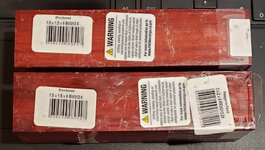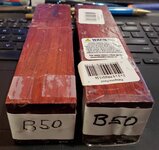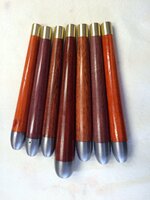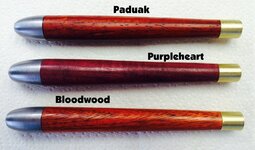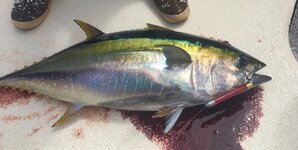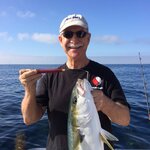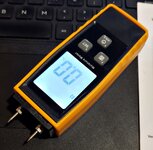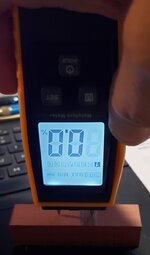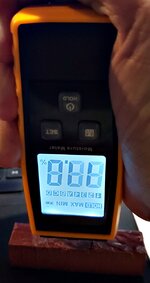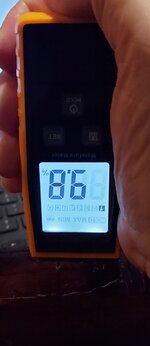You are using an out of date browser. It may not display this or other websites correctly.
You should upgrade or use an alternative browser.
You should upgrade or use an alternative browser.
Bloodwood cracking?
- Thread starter qquake
- Start date
Signed-In Members Don't See This Ad
Signed-In Members Don't See This Ad
jttheclockman
Member
All wood can crack. There are many so called bloodwood blanks being used these days. I think this had internal cracks in already. Remember you are thinning the wood to almost nothing so any movement can and will cause cracks. If a real bloodwood it is an oily wood and most times come covered in wax to prevent drying too fast. Needs to be treated as such. Good luck.
qquake
Member
What do you mean "needs to be treated as such"? What could I have done differently? And yes, it was waxed.All wood can crack. There are many so called bloodwood blanks being used these days. I think this had internal cracks in already. Remember you are thinning the wood to almost nothing so any movement can and will cause cracks. If a real bloodwood it is an oily wood and most times come covered in wax to prevent drying too fast. Needs to be treated as such. Good luck.
Attachments
jttheclockman
Member
Let it dry. It needs to be dry before worked. Moisture meter or weighing is a way to determine when ready to work. I will slice the wax off when I can.
monophoto
Member
Something is puzzling me - the pictures of the blanks are show two labels - one as 'Bloodwood' and the other as 'Patagonian Rosewood".
Patagonian Rosewood is a marketing name that is applied to either of two species of timber - Guibourtia hymenaeifolia, aka Tiete Rosewood or Anadenanthera colubrina, aka Curupay, both of which originate in tropical areas of South America (ie, the northern part of the continent. Both are brown/yellow in color. Bloodwood (Brosimum rubescens) comes from a different tree that grows in the southern part of South America and is a dull red color. The pictures certainly appear to be Bloodwood, but the labeling appears to be erroneous.
But to John's point - tropical woods are often waxed and packaged for sale while still green (wet) and must be allowed to dry and shrink before being turned.
Patagonian Rosewood is a marketing name that is applied to either of two species of timber - Guibourtia hymenaeifolia, aka Tiete Rosewood or Anadenanthera colubrina, aka Curupay, both of which originate in tropical areas of South America (ie, the northern part of the continent. Both are brown/yellow in color. Bloodwood (Brosimum rubescens) comes from a different tree that grows in the southern part of South America and is a dull red color. The pictures certainly appear to be Bloodwood, but the labeling appears to be erroneous.
But to John's point - tropical woods are often waxed and packaged for sale while still green (wet) and must be allowed to dry and shrink before being turned.
Last edited:
I always assume if a blank is covered in wax then it is probably wet (green). Keep in mind that wood will dry faster from endgrain, and also it will shrink across the grain more than with the grain (this is why tables will have loose tenon breadboard ends - the wood will move a lot along the width, but not as much on the length). It is this movement that causes the crack - the wood is shrinking as it dries but has nowhere to go because of the brass tube. If you remove the wax leave the wax on the ends as this will help prevent cracking/checking. Pen blanks will dry fairly quick - a couple weeks to a month or so. Weigh them with a kitchen scale and write the weight on them, check weekly and when the weight stop dropping they are dry. I would expect to lose about 10-15% of the weight of a waxed blank from a major outlet that has a lot of turnover. But this depends on a lot of factors. The "1 year per inch of thickness" rule of thumb that you'll find for air drying lumber doesn't really apply to pen blank sizes. You can speed up drying by using a dehumidifier, toaster oven, microwave, boiling in water, placing in a warm spot like the dash of your car, or a place with good air flow like a HVAC return.
Bloodwood isn't particularly prone to cracking. Use some care to not generate too much heat while drilling. I like to use gorilla glue (foaming urethane type) for gluing tubes - I feel that this allows for some movement of the wood material relative to the brass.
Bloodwood isn't particularly prone to cracking. Use some care to not generate too much heat while drilling. I like to use gorilla glue (foaming urethane type) for gluing tubes - I feel that this allows for some movement of the wood material relative to the brass.
qquake
Member
Only one of the blanks has the Patagonian rosewood label on it, but it also has a bloodwood label on it. I'm guessing it's bloodwood because of the size listed (1.5" x 1.5" x 6").Something is puzzling me - the pictures of the blanks are show two labels - one as 'Bloodwood' and the other as 'Patagonian Rosewood".
Patagonian Rosewood is a marketing name that is applied to either of two species of timber - Guibourtia hymenaeifolia, aka Tiete Rosewood or Anadenanthera colubrina, aka Curupay, both of which originate in tropical areas of South America (ie, the northern part of the continent. Both are brown/yellow in color. Bloodwood (Brosimum rubescens) comes from a different tree that grows in the southern part of South America and is a dull red color. The pictures certainly appear to be Bloodwood, but the labeling appears to be erroneous.
But to John's point - tropical woods are often waxed and packaged for sale while still green (wet) and must be allowed to dry and shrink before being turned.
leehljp
Member Liaison
I will chime in on "is Bloodwood really Bloodwood". I am finding more different colors now for "bloodwood", i.e. the name seems to be gravitating towards generic. It used to have a deep maroonish red color as yours has. Your pictures reminds me of the bloodwood that I have. In the last couple of years, I have seen wood labeled and called "bloodwood" on this forum that is not like what it was 10 and 15 years ago. The grain on yours looks very close to mine also.
I bought a 1" x 8" by 6ft bloodwood board about 13 or 14 years ago and still have about one third of it. I have kept it hidden, away from light and it is still beautiful maroonish red. BUT, I have not had any crack like that.
I bought a 1" x 8" by 6ft bloodwood board about 13 or 14 years ago and still have about one third of it. I have kept it hidden, away from light and it is still beautiful maroonish red. BUT, I have not had any crack like that.
mmayo
Member
I have turned a lot of bloodwood for my pens, but especially for my cedar plugs. I usually buy large boards if possible and cut to suit. Cracks are a fact of life with this wood. If I see them I toss the blanks or save the useful part for a shorter project like a Sierra. All that said, the stuff turns very well, sands to ultra smooth and takes CA perfectly. Someone on this forum sold me a large flat rate box filled with old growth R E D bloodwood. My postman hated me for months due to the extreme weight. Best stuff I've even seen and not like the pale stuff I buy now.
Attachments
Last edited:
qquake
Member
I really like that padauk. Very sharp.
mmayo
Member
I really like that padauk. Very sharp.
The right photo is from the 0-100 stage of my "cedar" plug development whereas the left photo is in the 400-600 stage. I guess an old dog can learn new tricks.
qquake
Member
What exactly are they for?The right photo is from the 0-100 stage of my "cedar" plug development whereas the left photo is in the 400-600 stage. I guess an old dog can learn new tricks.
mmayo
Member
To catch fish when trolled behind a moving boat. Shown is a yellowfin tuna (Ahi at a sushi bar) and yellowtail (hamachi at a sushi bar).What exactly are they for?
Attachments
qquake
Member
Oh, a fishing plug! That's awesome!
Penchant 4
Member
FWIW--weight change of raw wood is a means of determining moisture content equilibrium with the environment. It does not necessarily indicate dryness. If the the humidity of the atmosphere is 40%, the moisture content of the wood will be higher than if the humidity is 12%. One will be DRYER than the other; but not necessarily DRY. My $0.02.
qquake
Member
I ordered a moisture meter so I can know for sure.
qquake
Member
monophoto
Member
Okay, on a cut side of one of the blanks, I got 0%. On the waxed side, got 11%. I think. On the waxed uncut block, I got 9%. Thoughts?
Seems reasonable - cutting the blank exposes raw wood which can dry further, while the surfaces covered in wax still retain moisture.
The numerical values may not be meaningful. Some people have a reference lump of wood that they keep around as a way of calibrating a moisture meter - since that block of wood remains in the shop at all times, it pretty much stabilizes with the ambient humidity, and other than minor seasonal variations, a meter reading taken from it should be pretty consistent. But lacking a reference measurement, the value of a moisture meter is mainly in telling you whether the wood you are testing is 'generally wet' or 'generally dry', and measurements over time will tell you if it is drying.
qquake
Member
jttheclockman
Member
Again all redheart is not redheart but sold as such. All woods can crack. No scientific way to prevent that I know of. Wood can have internal stress from the way it grew on the tree and harvested. Wood can be too dry, or can be too wet and when exposed to air dry too quickly. When using exotic woods it is always a good idea to treat as if it will crack. Slowly turn the blank end for end at even rates. In other words do not turn ends down alot more than the middle when sizing. Do it in an orderly fashion so as to not stress parts of the wood. Need to let wood acclimate to climate in which it is being worked. If waxed turn off wax and let sit to dry before spinning to shape. Weighing wood is a good way to test water content. When it stops losing weight it has stabilized to the area it is being worked. Does not mean it is dry but has stabilized. And most important heat is the enemy in whatever we do with pens so try not to heat the blank by turning it down so fast and always use sharp tools.



